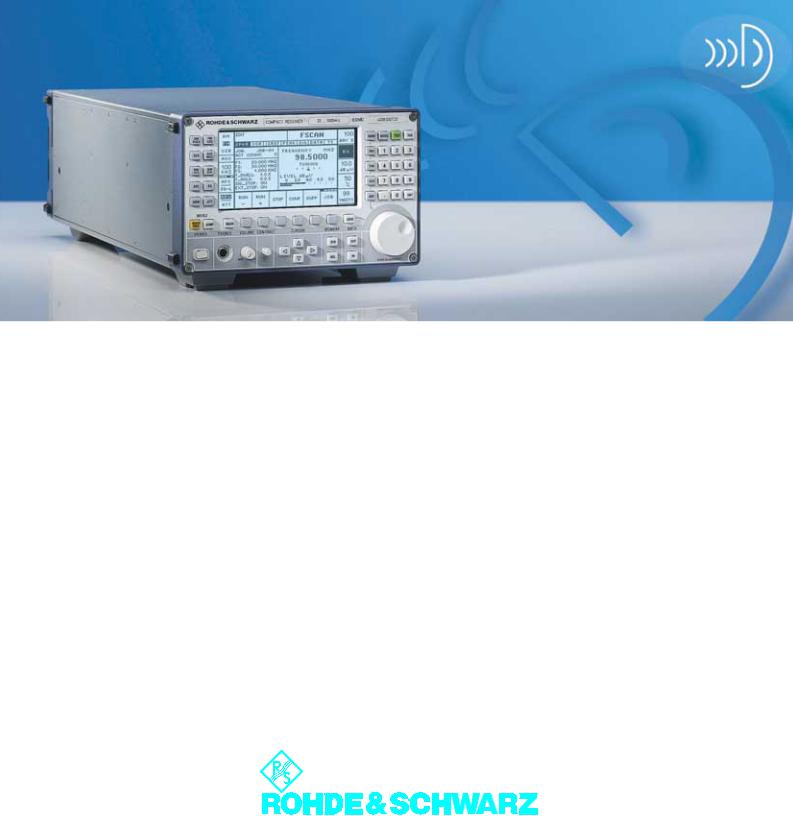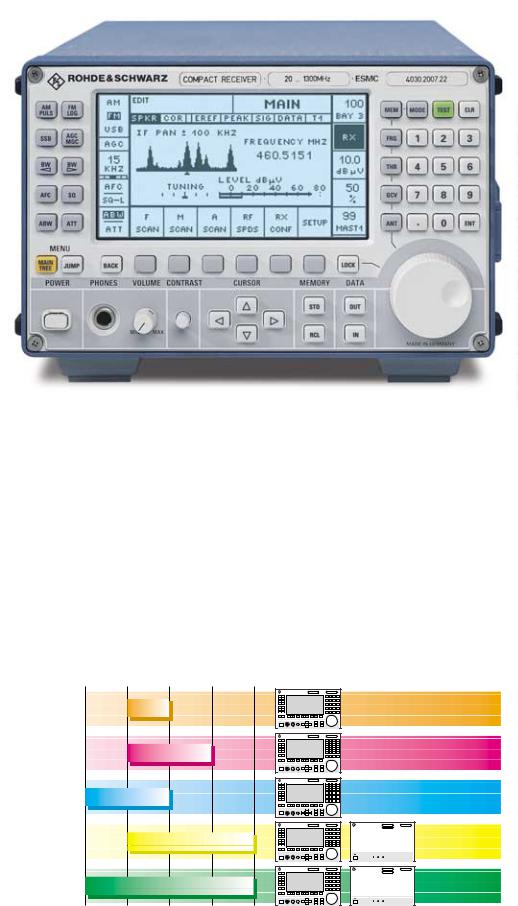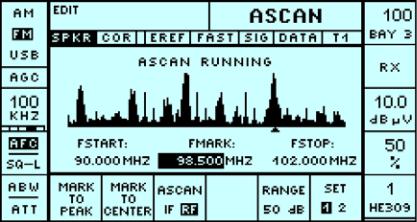Rohde&Schwarz ESMC User Guide

Compact Receiver ESMC
Lightweight – compact – user-friendly:
optimized radiomonitoring from 0.5 MHz to 3000 MHz
• |
Signal reception |
• Searching and scanning |
• |
Measurement of |
|
– aural monitoring |
– continuous manual tuning |
|
– frequency occupancy |
|
– radiomonitoring |
– at any channel spacing |
|
– level and frequency |
|
– recording |
– 5 start/stop frequency ranges |
|
– coverage |
• |
1 Hz frequency resolution |
– spectrum display with a |
• |
RF and IF spectrum display |
|
|
speed of up to 13 GHz/s |
|
|
|
|
– within 1000 memory locations |
|
|

With the Compact Receiver ESMC, a universal and multipurpose receiver for radiomonitoring applications has been produced in a compact size that was thought not possible up to now.
The new receiver is only half the size of customary 19" multipurpose receivers of 3 height units but its technical data are even superior to those of such units.
The most important features are:
•custom-specific frequency extension
from HF to UHF (see diagram)
•detection of frequency-agile emissions with analog sweep
•compact design and low weight
•simple operation via LC display
•wide dynamic range and high overload capacity
•1 Hz frequency resolution
•low phase noise
•master/slave operation without a PC
•accurate measurement of signal level
•offset display for channel frequency
•remote control unit for mobile use
•AC/DC supply without changing the power supply unit
Operation
The operating concept meets all the demands made on a state-of-the-art radiomonitoring receiver, ie all main functions such as type of demodulation, bandwidth, etc, can be set directly via labelled keys. A hotkey permits returning to the main menu from any submenu. Menu control is organized in priority levels so that signal processing is not interrupted by menu changes and the user never loses sight of what is going on.
Description
ESMC is a heterodyne receiver with a second IF of 21.4 MHz. In spite of the compact design, no compromises have been made in the operating concept.
For reducing the total signal load, the tuners are each provided with a tracking preselection filter. High-level mixers
ensure high immunity to intermodulation. The low oscillator reradiation is the result of elaborate filtering. An advanced synthesizer concept featuring a very low phase noise allows switching times of less than 1 ms. This permits highly efficient scanning and fast status assignment in slave operation.
Compact Receiver ESMC: radiomonitoring from 0.5 MHz to 3000 MHz
Frequency range |
Device view |
Basic configuration |
|
ROHDE & SCHWARZ |
|
20 MHz to |
ESMC |
|
650 MHz |
||
|
||
|
ROHDE & SCHWARZ |
|
|
20 MHz to 1300 MHz |
|
|
ESMC,, ESMC-T2 |
|
|
|
|
|
|
ROHDE & SCHWARZ |
|
0.5 MHz to 650 MHz |
|
|
|
ESMC,, ESMC-T0 |
||
|
|
|
|
|
ROHDE & SCHWARZ |
ROHDE & SCHWARZ |
|
|
20 MHz to 3000 MHz |
|
|
ESMC,, ESMC-T2,, |
|
|
|
|
|
ESMC-FE |
||
|
|
|
|
|
|
|
|
|
|
|
|
ROHDE & SCHWARZ |
ROHDE & SCHWARZ |
|
0.5 MHz to 3000 MHz |
|
|
ESMC,, ESMC-T2,, |
||
|
|
|
ESMC-FE,, ESMC-T0,, |
|||
|
|
|
|
|
|
ESMC-TC |
MHz |
MHz |
MHz |
MHz |
MHz |
Configuration 0.5 MHz...1300 MHz on request |
|
0.5 |
20 |
650 |
1300 |
3000 |
|
|
2 Compact Receiver ESMC

ESMC is equipped with demodulators for AM, FM, LOG and PULSE modes. SSB reception for LSB/USB and A1 is optional. The log demodulator allows a dB-linear level indication over 9 decades. Average value or peak weighting may be selected. The absolute accuracy of the level display is further improved by taking into account the frequency response of the preselection filter and the tolerances of the log amplifier in the measurement of the signal level.
ESMC may be equipped with up to 5 IF bandwidths between 500 Hz and
8 MHz. Video filters matched to the bandwidth used and a switchable AF filter improve the S/N ratio after demodulation.
AGC covers a level range of 120 dB, 90 dB of which is used for IF control and 30 dB for an attenuator at the tuner input which may be switched in automatically or manually when strong signals are received. This attenuator is considered in the level display. With manual gain control (MGC) the IF gain may be varied by 90 dB. The 30 dB attenuation too may be switched in if required.
A tuning indication controlled by the crystal discriminator simplifies tuning to the center of the selected IF bandwidth. When signals of unstable frequency are received, digital AFC may be used for retuning the receiver.
Search facilities
The ESMC uses highly advanced search routines. Fast synthesizer settling and short level measurement times guarantee highly effective search operations. The shortest period for scanning is 5 ms with an IF bandwidth of 15 kHz (incl. measurement time for level).
Frequency scan
Five start/stop frequency ranges (5 jobs) may be defined and a complete data set allocated to each range. In addition to receiver settings, the following scan parameters may be included in the data set:
–step width
–signal threshold (dB V)
–dwell time (s)
–hold time (ms) plus the time required for external devices,
if any
–number of scan repetitions
–signal-controlled continuation (on/off)
–suppression (individual frequencies or ranges)
Memory scan
ESMC uses 1000 memory locations, each holding a complete receiver setting, such as frequency, type of modulation, bandwidth, etc. The content of the memory can be modified manually or overwritten by results of a scan operation. User-definable code names, group ID and scan enable flags may also be defined for each location. Final-
ly the whole memory can be sorted according to increasing frequency values. The content of any memory location can be transferred to the receiver manually, by using the RCL key, by turning the tuning knob or automatically by activating the memory scan.
Analog scan – full-speed detection of bursts and hoppers
The advantage of analog sweep is the extremely high speed. This allows detection of burst signals and frequency-agile transmissions. With the option ESMC-AS and an external PC a program under Windows™ is provided, which enables panoramic and waterfall displays. Start and stop frequency are freely selectable within any tuner range. Depending on the performance of the controlling PC, a scanning speed of up to 13 GHz/s can be achieved. With the aid of a printer, measurement results may be documented as a frequen- cy-versus-time plot.
Click & listen
For fixed frequency monitoring a spectrum line can be selected by mouse click or by frequency marker.
With option ESMC-AS fast hopping frequencies can be detected
Compact Receiver ESMC |
3 |
